
Theodore is a town and a locality in the Shire of Banana, Queensland, Australia. It was established in the 1920s as part of Queensland Premier Ted Theodore's ambitious Dawson River Irrigation Scheme which failed to eventuate. It was originally known as Castle Creek, but that name is now used by another locality in the area.
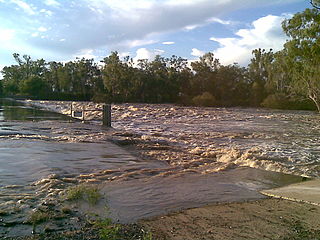
The Dawson River is a river located in Central Queensland, Australia.

The gastropod shell is part of the body of a gastropod or snail, a kind of mollusc. The shell is an exoskeleton, which protects from predators, mechanical damage, and dehydration, but also serves for muscle attachment and calcium storage. Some gastropods appear shell-less (slugs) but may have a remnant within the mantle, or the shell is reduced such that the body cannot be retracted within (semi-slug). Some snails also possess an operculum that seals the opening of the shell, known as the aperture, which provides further protection. The study of mollusc shells is known as conchology. The biological study of gastropods, and other molluscs in general, is malacology. Shell morphology terms vary by species group. An excellent source for terminology of the gastropod shell is "How to Know the Eastern Land Snails" by John B. Burch now freely available at the Hathi Trust Digital Library.

Vertigo angustior, the narrow-mouthed whorl snail, is a species of minute land snail, a terrestrial pulmonate gastropod mollusk or micromollusk in the family Vertiginidae, the whorl snails.
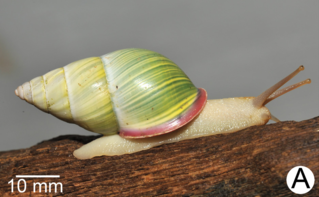
Amphidromus is a genus of tropical air-breathing land snails, terrestrial pulmonate gastropod mollusks in the family Camaenidae. The shells of Amphidromus are relatively large, from 25 mm (0.98 in) to 75 mm (3.0 in) in maximum dimension, and particularly colorful. During the 18th century, they were among the first Indonesian land snail shells brought to Europe by travelers and explorers. Since then, the genus has been extensively studied: several comprehensive monographs and catalogs were authored by naturalists and zoologists during the time period from the early 19th to the mid 20th centuries. Modern studies have focused on better understanding the evolutionary relationships within the group, as well as solving taxonomic problems.
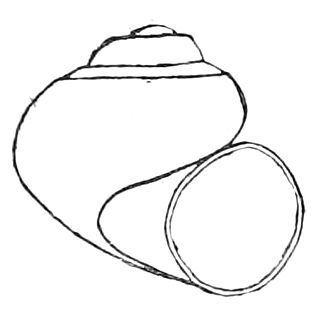
The Utah roundmouth snail, also known as the Utah valvata or desert valvata, scientific name Valvata utahensis, is a species of freshwater snail with a gill and an operculum, an aquatic gastropod mollusc in the family Valvatidae, the valve snails.

Camaenidae is a family of air-breathing land snails, terrestrial pulmonate gastropod mollusks in the superfamily Helicoidea, the typical snails and their allies. This is one of the most diverse families in the clade Stylommatophora.

Cittarium pica, common name the West Indian top shell or magpie shell, is a species of large edible sea snail, a marine gastropod mollusk in the family Tegulidae. This species has a large black and white shell.
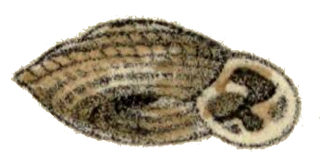
Plectopyloidea is a taxonomic superfamily of air-breathing land snails, terrestrial pulmonate gastropod mollusks in the informal group Sigmurethra.
Crikey steveirwini is a species of air-breathing land snail, a terrestrial pulmonate gastropod mollusc in the family Camaenidae. Crikey steveirwini is the only species in the genus Crikey.
Gnarosophia bellendenkerensis is a species of air-breathing land snail, a terrestrial pulmonate gastropod mollusk in the family Camaenidae.
Chloritis vanbruggeni is a species of air-breathing land snail, a terrestrial pulmonate gastropod mollusk in the family Camaenidae.
Chloritis togianensis is a species of air-breathing land snail, a terrestrial pulmonate gastropod mollusk in the family Camaenidae.
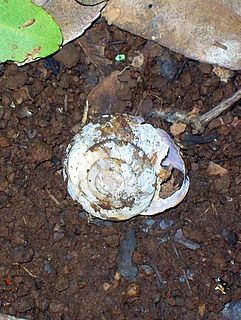
Pommerhelix monacha is a species of air-breathing land snail, a terrestrial pulmonate gastropod mollusc in the family Camaenidae. This species is found in eastern Australia.

Noctepuna cerea is a species of air-breathing land snail, a terrestrial pulmonate gastropod mollusc in the family Camaenidae. This species is endemic to Australia.
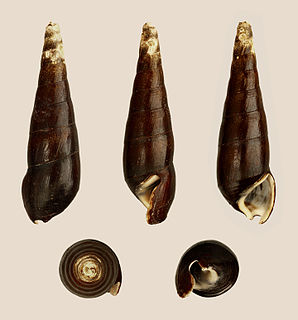
Faunus ater is a species of brackish water snail with an operculum, an aquatic gastropod mollusk in the family Pachychilidae.
In the Taroom district in the Dawson River valley of Queensland, Australia, a boggomoss is a mound spring. Boggomosses range in form from small muddy swamps to elevated peat bogs or swamps, up to 150 meters across scattered among dry woodland communities, which form part of the Springsure Group of Great Artesian Basin springs. They are rich in invertebrates and form a vital chain of permanently moist oases in an otherwise dry environment.

Bolma aureola, common name the golden turbo shell or the scaly star shell, is a species of sea snail, a marine gastropod mollusk in the family Turbinidae, the turban snails.

Adclarkia is a genus of air-breathing land snails, terrestrial pulmonate gastropod mollusks in the family Camaenidae.

Papuina trochiformis is a species of air-breathing land snail, a terrestrial pulmonate gastropod mollusk in the family Camaenidae.
















